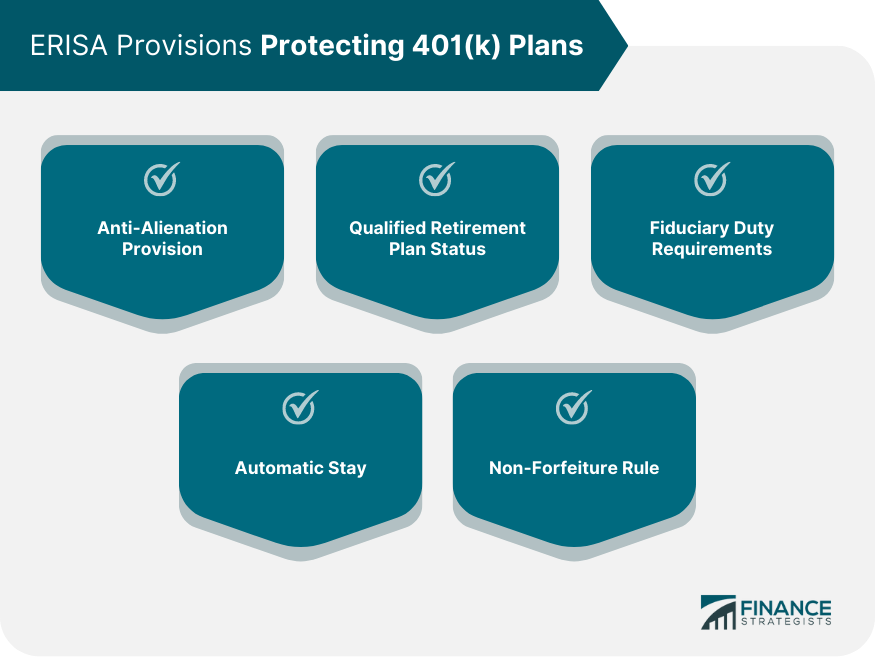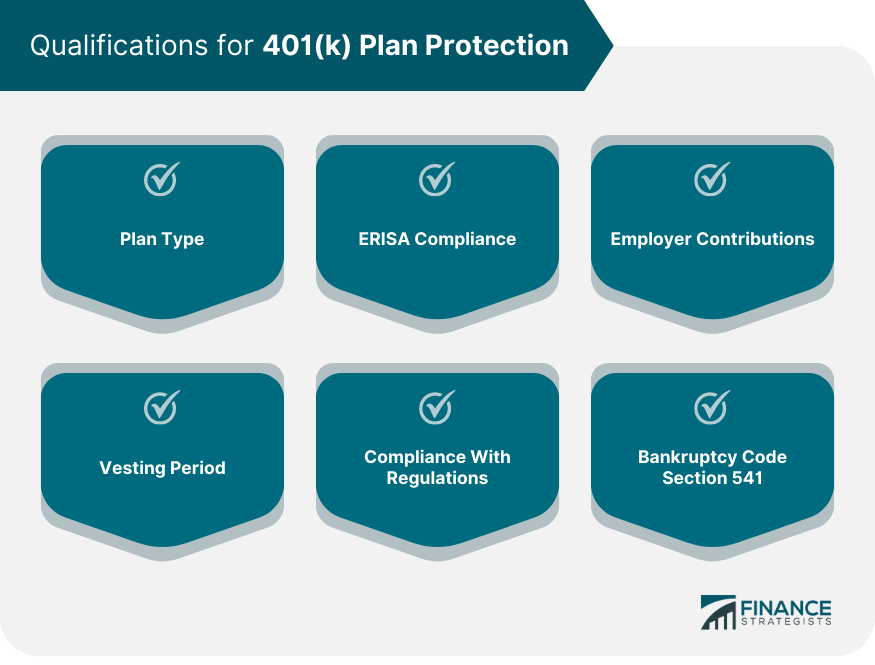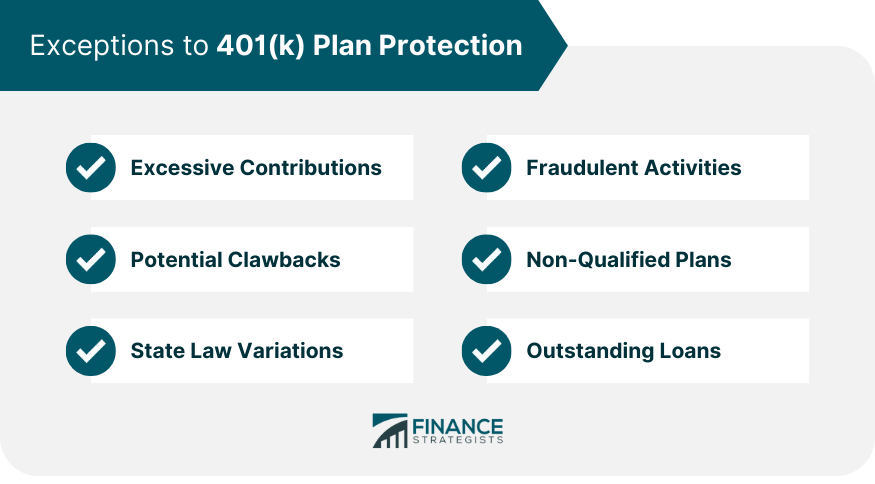Bankruptcy is a legal process used by individuals or businesses overwhelmed by debt. It offers a fresh start by either eliminating or reorganizing debt. However, it raises concerns about the protection of retirement savings, particularly 401(k) accounts. During financial difficulties, individuals worry about the safety of their 401(k) plans. The good news is that, in most cases, 401(k) plans enjoy substantial protections. The Employee Retirement Income Security Act (ERISA) exempts these plans from being part of the bankruptcy estate. Creditors generally cannot access these funds to satisfy debts, providing significant protection for retirement savings. The ERISA serves as a crucial safeguard for retirement savings, including 401(k) plans. ERISA sets forth comprehensive standards and regulations for employer-sponsored retirement plans, including requirements for plan disclosures, fiduciary responsibilities, and participant rights. It establishes fiduciary obligations for plan administrators, ensuring that they act in the best interests of plan participants and manage the plan prudently. ERISA provides safeguards for participants' benefits by mandating vesting requirements, prohibiting certain types of plan amendments, and establishing the Pension Benefit Guaranty Corporation (PBGC) to provide protection for pension plans in case of plan termination. ERISA's anti-alienation provision prevents creditors from accessing the assets within a 401(k) plan. This provision ensures that the funds contributed to the plan remain protected and cannot be seized by creditors to satisfy outstanding debts during bankruptcy proceedings. To receive ERISA protections, a 401(k) plan must meet certain criteria and be deemed a qualified retirement plan. This status grants the plan additional safeguards, shielding it from potential creditors' claims and ensuring it remains intact during the bankruptcy process. The ERISA imposes fiduciary duties on plan administrators, requiring them to act prudently and solely in the interest of plan participants and beneficiaries. These obligations ensure that the 401(k) plan's assets are managed responsibly, further enhancing the plan's protection. During bankruptcy, the automatic stay halts all collection actions against the debtor, including actions against their 401(k) plan. This provision provides temporary relief, preventing creditors from attempting to access the plan's assets during the bankruptcy process. ERISA's non-forfeiture rule ensures that a participant's vested benefits in the 401(k) plan are not forfeited, regardless of the bankruptcy situation. This ensures that employees retain their earned benefits and promotes long-term financial security. The type of 401(k) plan plays a significant role in determining eligibility. Both traditional 401(k) plans and Roth 401(k) plans can be protected, but their treatment may differ. Traditional 401(k) plans consist of pre-tax contributions, while Roth 401(k) plans are funded with after-tax contributions. The protection of these plans depends on whether they meet the required criteria. Plans that are subject to the ERISA are more likely to be eligible for protection. ERISA provides strict guidelines for employer-sponsored retirement plans, including 401(k) plans, to ensure they meet certain standards and protect employees' interests. The presence of employer contributions can impact a plan's eligibility for protection. Plans with significant employer contributions may be more likely to qualify, as these contributions are typically considered as additional benefits tied to employment. The vesting period of the plan is another crucial consideration. Plans that have fully vested are more likely to be eligible for protection as the funds have become the property of the plan participant and are no longer subject to forfeiture. Ensuring that the 401(k) plan complies with all relevant federal regulations is essential for eligibility. This includes adhering to contribution limits, distribution rules, and other requirements set by the Internal Revenue Service (IRS). Bankruptcy Code Section 541 defines the property included in the bankruptcy estate. Eligibility for protection under Section 541 requires that the 401(k) plan satisfies the requirements outlined in the code. Compliance with federal regulations and plan requirements is a critical aspect of ensuring the protection of a 401(k) plan in bankruptcy. Failure to meet these guidelines can jeopardize the plan's eligibility for protection, potentially exposing the retirement savings to creditors during bankruptcy proceedings. Several key federal regulations and plan requirements must be adhered to: The IRS sets annual contribution limits for 401(k) plans. It is essential for plan participants to stay within these limits to maintain the plan's qualified status and preserve its protection in bankruptcy. 401(k) plans have specific distribution rules, including the age at which withdrawals can be made without penalty. Abiding by these rules is crucial to maintain the plan's tax-advantaged status and protect it from adverse consequences in bankruptcy. Having clear and accurate plan documentation is essential to demonstrate compliance with regulations. This includes plan summaries, participant notices, and financial reports. Courts may scrutinize 401(k) contributions made close to the bankruptcy filing. If the contributions are deemed excessive and made with the intention of shielding assets from creditors, they might not be fully protected. Courts aim to prevent individuals from using retirement accounts as a last-minute shelter to hide wealth from creditors. If an individual is found to have engaged in fraudulent activities related to their 401(k) plan, such as misrepresenting assets or providing false information, the court may disregard the protection for that specific plan. Fraudulent actions jeopardize the integrity of the bankruptcy process and may lead to the forfeiture of protection for retirement savings. In some cases, bankruptcy trustees may initiate clawback actions to recover contributions made to a 401(k) plan within a specific period before the bankruptcy filing. This could occur if the trustee suspects that the contributions were made with the intent of defrauding creditors or concealing assets. Certain 401(k) plans may not be qualified under the Internal Revenue Code, and as a result, might not receive the same level of protection in bankruptcy. Non-qualified plans are typically offered to select executives and may not benefit from the same statutory protections as qualified plans. While the Employee Retirement Income Security Act (ERISA) provides federal protections for qualified 401(k) plans, state laws can differ and may introduce exceptions. It is essential to understand the specific state laws governing bankruptcy and 401(k) plan protection. Outstanding loans taken from a 401(k) plan can be a point of contention during bankruptcy. If the court determines that the participant intentionally defaulted on the loan to shield assets, the protection of the entire plan may be jeopardized. Bankruptcy Code Section 522 is a fundamental provision within the U.S. Bankruptcy Code that addresses exemptions available to debtors during bankruptcy proceedings. Section 522 allows debtors to choose between federal and state-specific exemptions, depending on the bankruptcy jurisdiction in which they file their case. This choice often presents a critical decision point for individuals, as federal exemptions may provide more robust protection for retirement accounts, including 401(k) plans, compared to state exemptions. While the homestead exemption primarily pertains to the protection of a debtor's primary residence, its implications can indirectly affect other exemptions, including those for retirement accounts. Some states offer a wildcard exemption, which allows debtors to exempt a certain dollar amount of any property they choose. Utilizing the wildcard exemption strategically can enhance the protection of retirement savings and other valuable assets. Bankruptcy Code Section 522 specifically includes provisions for retirement accounts, recognizing the significance of preserving these funds for individuals' financial security in their post-retirement years. Given the complexities of Bankruptcy Code Section 522 and the strategic decisions it entails, consulting with bankruptcy attorneys is highly recommended. Legal experts can provide personalized guidance, ensuring debtors make well-informed choices to maximize the protection of their 401(k) plans and navigate the bankruptcy process successfully. When it comes to protecting 401(k) plans in bankruptcy, state laws and exemptions play a crucial role in shaping the level of protection offered to retirement savings. While federal regulations provide a baseline of protection, individual states have the authority to implement their own rules and exemptions, which can significantly impact the outcome for 401(k) plan holders during bankruptcy proceedings. State laws determine the maximum amount of 401(k) funds that can be exempted from bankruptcy proceedings. These exemption amounts vary widely from state to state, ranging from a few thousand dollars to an unlimited exemption in some cases. Understanding the specific exemption amount in one's state of residence is vital, as it dictates how much of the retirement savings can be shielded from creditors. In some instances, individuals filing for bankruptcy may have the option to choose between federal bankruptcy exemptions and state-specific exemptions. Making the right choice can have significant consequences for protecting 401(k) assets. Comparing the benefits and limitations of both sets of exemptions is essential to make an informed decision. Some states require individuals to meet specific residency requirements to qualify for their state-level exemptions. If an individual has recently moved to a new state, they may be subject to different exemption rules, impacting the protection afforded to their 401(k) plans. In states that allow the use of federal bankruptcy exemptions, individuals can choose to utilize federal non-bankruptcy exemptions to complement their state-level protections. This option can provide additional safeguards for other assets beyond 401(k) plans. Some states offer additional protections for specific types of retirement plans, including 401(k) plans, beyond the standard exemptions. These unique provisions can further enhance the security of retirement savings in bankruptcy. Given the significant impact of state laws on 401(k) plan protection, individuals contemplating bankruptcy may consider engaging in bankruptcy exemption planning. This involves strategic actions to maximize the use of favorable exemptions, potentially positioning 401(k) plans and other assets for greater protection. As state laws governing bankruptcy exemptions can be complex and subject to change, seeking guidance from experienced bankruptcy attorneys is crucial. Legal experts can provide insights into state-specific rules and help individuals make the most informed decisions regarding the protection of their retirement savings. In conclusion, individuals facing bankruptcy often express concerns about the protection of their 401(k) plans. Fortunately, in most cases, 401(k) plans enjoy substantial protections. The Employee Retirement Income Security Act (ERISA) exempts these plans from being part of the bankruptcy estate, preventing creditors from accessing these funds to satisfy debts. ERISA provisions such as the anti-alienation provision, qualified retirement plan status, fiduciary duty requirements, automatic stay, and non-forfeiture rule contribute to the protection of 401(k) plans. Additionally, eligibility for protection depends on factors such as plan type, ERISA compliance, employer contributions, vesting period, compliance with federal regulations, and meeting requirements outlined in Bankruptcy Code Section 541. Exceptions to 401(k) plan protection include excessive contributions, fraudulent activities, potential clawbacks, non-qualified plans, state law variations, and outstanding loans. Understanding the nuances of Bankruptcy Code Section 522 and state-specific regulations is crucial. Consulting with bankruptcy attorneys can provide valuable guidance and ensure that individuals make informed decisions to maximize the protection of their 401(k) plans and navigate the bankruptcy process successfully.Understanding Bankruptcy and Its Impact on Personal Finances
The Employee Retirement Income Security Act (ERISA) and 401(k) Protection
Role of the ERISA in Safeguarding Retirement Savings
Specific ERISA Provisions for Protecting 401(k) Plans
Anti-Alienation Provision
Qualified Retirement Plan Status
Fiduciary Duty Requirements
Automatic Stay
Non-Forfeiture Rule

Qualifications for 401(k) Plan Protection
Eligibility Criteria
Plan Type
ERISA Compliance
Employer Contributions
Vesting Period
Compliance With Federal Regulations
Bankruptcy Code Section 541

Federal Regulations and Plan Requirements
Contribution Limits
Distribution Rules
Plan Documentation
Exceptions to 401(k) Plan Protection
Excessive Contributions
Fraudulent Activities
Potential Clawbacks
Non-Qualified Plans
State Law Variations
Outstanding Loans

Bankruptcy Code Section 522 and Exemptions
Federal vs State Exemptions
Homestead Exemption
Wildcard Exemption
Importance for Retirement Accounts
Legal Counsel
State-Specific Regulations and Exemptions Affecting 401(k) Plan Protection
Variability in Exemption Amounts
Choice of State Exemptions
State Residency Requirements
Interaction With Federal Exemptions
State-Specific Protections
Bankruptcy Exemption Planning
Consultation With Legal Experts
Conclusion
Is Your 401(k) Protected in a Bankruptcy? FAQs
In most cases, yes. 401(k) plans enjoy substantial protections through the Employee Retirement Income Security Act (ERISA), which exempts them from being part of the bankruptcy estate. Creditors generally cannot access these funds to satisfy debts, providing significant protection for your retirement savings.
Yes, ERISA serves as a crucial safeguard for retirement savings, including 401(k) plans. It sets comprehensive standards and regulations for employer-sponsored retirement plans, ensuring fiduciary obligations, vesting requirements, and establishing protections to shield your 401(k) from creditors during bankruptcy.
ERISA provisions such as the anti-alienation provision, qualified retirement plan status, fiduciary duty requirements, automatic stay, and non-forfeiture rule offer significant protection for your 401(k) account during bankruptcy proceedings.
While 401(k) plans are generally well-protected, some exceptions exist. Excessive contributions, fraudulent activities, potential clawbacks, non-qualified plans, state law variations, and outstanding loans can impact the level of protection for your 401(k) in bankruptcy.
Yes, consulting with bankruptcy attorneys is highly recommended. Given the complexities of Bankruptcy Code Section 522, state-specific regulations, and exemption planning, legal experts can provide personalized guidance to maximize the protection of your 401(k) and navigate the bankruptcy process successfully.
True Tamplin is a published author, public speaker, CEO of UpDigital, and founder of Finance Strategists.
True is a Certified Educator in Personal Finance (CEPF®), author of The Handy Financial Ratios Guide, a member of the Society for Advancing Business Editing and Writing, contributes to his financial education site, Finance Strategists, and has spoken to various financial communities such as the CFA Institute, as well as university students like his Alma mater, Biola University, where he received a bachelor of science in business and data analytics.
To learn more about True, visit his personal website or view his author profiles on Amazon, Nasdaq and Forbes.











